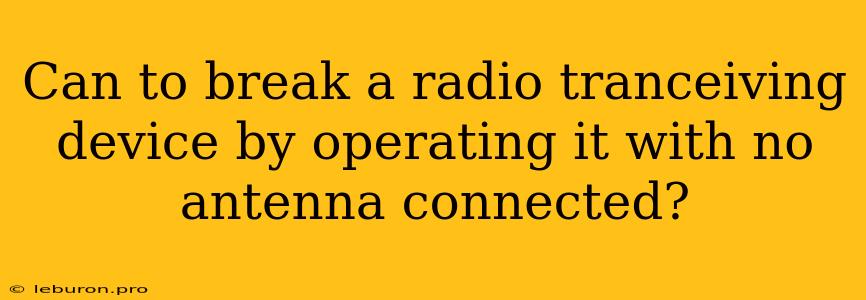The question of whether operating a radio transceiver without an antenna can damage the device is a common one, especially among those new to radio communication. While it's true that antennas are essential for radio signals to propagate and communicate effectively, the impact of operating a transceiver without an antenna is more nuanced than simply causing damage. This article delves into the complexities of this scenario, exploring the potential consequences and explaining why it's generally not recommended to operate a radio transceiver without an antenna.
The Importance of Antennas in Radio Communication
To understand the implications of operating a radio transceiver without an antenna, it's crucial to grasp the role of antennas in radio communication. Antennas act as the interface between the radio waves generated by the transceiver and the surrounding environment. They effectively convert the electrical signals produced by the transceiver into electromagnetic waves that can propagate through the air. Conversely, they also capture incoming electromagnetic waves and convert them back into electrical signals for the receiver to process.
How Antennas Work
Antennas function by creating a fluctuating electric and magnetic field around them. When a radio transceiver transmits, the antenna oscillates at the designated frequency, radiating energy into the surrounding space. This energy propagates as electromagnetic waves, carrying the information encoded in the radio signal. Conversely, when receiving, the antenna intercepts these electromagnetic waves, inducing an oscillating current within its structure. This current is then amplified and processed by the transceiver's receiver circuitry to decode the received signal.
The Matching Impedance
A key aspect of efficient radio communication is the concept of impedance matching. Impedance refers to the resistance a circuit presents to the flow of electrical current. The transceiver's output stage is designed to operate at a specific impedance, typically 50 ohms. The antenna must also have a matching impedance to allow for maximum power transfer from the transceiver to the antenna. If the impedances don't match, some of the transmitted power is reflected back into the transceiver, potentially leading to damage or reduced efficiency.
Can Operating a Transceiver Without an Antenna Damage It?
The short answer is that it's not generally recommended to operate a radio transceiver without an antenna connected. While doing so might not immediately cause catastrophic damage, it can lead to several issues:
1. High SWR (Standing Wave Ratio)
The most immediate consequence of operating a transceiver without an antenna is a high Standing Wave Ratio (SWR). SWR measures the ratio of reflected power to forward power in a transmission line. Without an antenna to absorb the transmitted energy, the power is reflected back towards the transceiver. This reflected power can interfere with the normal operation of the transceiver, leading to poor performance, reduced efficiency, and potential damage to the output circuitry over time.
2. Overheating and Damage to the Final Amplifier
The reflected power from a high SWR can cause the final amplifier stage of the transceiver to overheat. This can result in decreased performance and even permanent damage to the amplifier components, potentially leading to the need for repairs.
3. Harmonic Distortion
Operating a transceiver without an antenna can also result in harmonic distortion. This is due to the reflected power causing the transceiver's output circuitry to operate in a non-linear manner. The distortion can manifest as unwanted signals at multiples of the intended transmission frequency, potentially interfering with other radio communications and causing unwanted noise.
4. Reduced Transmission Power
In some cases, operating without an antenna can lead to reduced transmission power. This occurs because the transceiver's internal circuitry might detect the high SWR and automatically reduce the output power to protect itself from damage. This reduces the communication range and effectiveness.
What Happens When You Transmit Without an Antenna?
When you transmit without an antenna, the power that is supposed to be radiated into the air is reflected back into the transceiver's internal circuitry. This reflected power can cause several issues:
- High SWR: As discussed previously, this leads to a mismatch between the transceiver's output impedance and the antenna's impedance. This can interfere with the normal operation of the transceiver and lead to potential damage.
- Overheating: The high SWR causes the final amplifier to work harder to compensate for the mismatch, leading to overheating. This can damage the amplifier components.
- Harmonic distortion: The reflected power can cause the output circuitry to operate in a non-linear way, producing unwanted signals at multiples of the intended transmission frequency.
- Reduced transmission power: Some transceivers have built-in protection mechanisms that automatically reduce the output power when they detect a high SWR. This limits the effectiveness of your transmission.
Alternatives to Operating Without an Antenna
Instead of running your transceiver without an antenna, consider these alternatives:
- Dummy load: This is a device designed to absorb radio frequency power without radiating it. It simulates the impedance of an antenna, allowing you to test your transceiver without transmitting.
- Short antenna: While a short antenna might not be as efficient as a longer one, it can still be a suitable alternative if you need to transmit in a situation where a full-size antenna is not practical.
- Antenna tuner: This device can match the impedance of your transceiver to the impedance of your antenna, minimizing the reflections and maximizing power transfer.
Conclusion
In conclusion, operating a radio transceiver without an antenna connected is not recommended due to the potential for high SWR, overheating, harmonic distortion, and reduced transmission power. While it might not immediately cause damage, it can lead to long-term issues and reduced performance.
Always ensure that a suitable antenna is properly connected to your radio transceiver. If you need to test your transceiver without transmitting, consider using a dummy load. By following these guidelines, you can ensure the optimal performance and longevity of your radio equipment.
